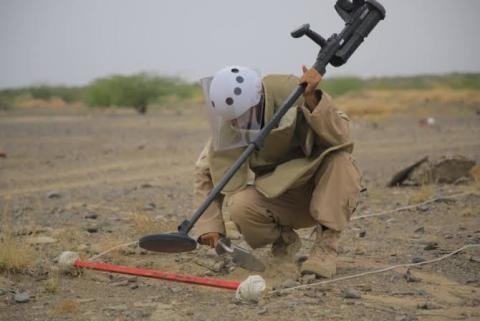Yemen’s health care system collapses under weight of pandemic


The UN Office for the Co-ordination of Humanitarian Affairs (OCHA) has warned that Yemen’s health care system has “in effect collapsed” and coronavirus is spreading across the country.
OCHA’s spokesperson Jens Laerke described the situation in Aden as “extremely alarming.” People were being turned away from treatment centres partly because staff lacked personal protective equipment (PPE). The city’s cemeteries are overflowing.
Laerke said OCHA’s efforts to combat the pandemic would fail without urgent financial support. Its programmes would have to close, and “then the world will have to witness what happens in a country without a functioning health system battling COVID-19. And I do not think the world wants to see that.”
While the authorities confirmed the first case of COVID-19 on April 10 and have reported 233 cases and 44 deaths since then, these figures are widely believed to be a vast underestimate of the scale of the pandemic. The absence of health care infrastructure across the war-torn country means that there is a lack of testing, many cases go undetected, and many are dying due to a lack of the most basic medical care.
On May 14, Save the Children said nearly 400 people in Aden died of coronavirus-like symptoms in just one week and warned that several hospitals in the city had closed, with medical staff refusing to go to work for lack of proper PPE.
Mohammed Alshamaa, Save the Children’s director of programmes in Yemen, said, “People are dying because they can’t get treatment that would normally save their lives. There are patients who go from hospital to hospital and yet cannot get admitted. We’re hearing of families who have lost two or three loved ones in the past few weeks.”
Medecins Sans Frontieres (MSF), which runs Aden’s only dedicated COVID-19 centre for the whole of southern Yemen, said that in the first 17 days of May it admitted 173 patients, at least 68 of whom died. Many patients were arriving at the centre already suffering from acute respiratory distress syndrome, making it hard to save their lives and suggesting that many more people were sick and dying at home.
Caroline Seguin, MSF’s operations manager in Yemen, said, “We are overwhelmed,” adding, “We were obliged to refuse patients because we didn’t have enough oxygen and medical staff to be able to treat the patients. So, it’s very heart breaking.” What they were seeing was “just the tip of the iceberg.”
MSF believes that 40 of its staff have been infected but cannot confirm this without testing. It estimates that about 80 people are dying in their homes every day in Aden, up from the normal 10 a day.
While the mortality level in its treatment centre was similar to European hospitals, the people dying were much younger—mostly men between 40 and 60 years old. She added that “Diseases such as malaria, dengue and chikungunya are endemic to the city, but they have never produced so many deaths in such a short amount of time.”
These diseases too have spread following the recent floods that ravaged much of the country, killing at least eight people in Aden, worsening water and electricity shortages, and affecting several hundred thousand people.
In March 2015, the Saudi monarchy launched a military campaign—primarily fought from the air—to suppress the Houthi rebels who had taken control of Sana’a, Yemen’s capital, and to reimpose the unelected puppet government of President Abd Rabbuh Mansur Hadi, now holed up in Riyadh.
The ensuing war has led to the death of more than 110,000 people, the wounding of hundreds of thousands more and the internal displacement of 3.6 million people. Saudi-led coalition’s airstrikes—more than 257,000 in the five-year war—initially targeted Yemen’s military establishment, but have since hit civilian targets, including homes, hospitals, schools, buses, and weddings, accounting for more than two-thirds of Yemen’s civilian casualties.
Saudi Arabia, aided and abetted by US and UK weapons, training, intelligence, aerial refueling, and Special Forces support, has pulverised Yemen’s physical and social infrastructure, including the destruction or closure of more than half of the country’s health care facilities and much of its water and sanitation network. Washington and London also ensured that the UN Security Council imposed sanctions against the Houthi rebels, without a single condemnation of Riyadh’s killing spree.
The Trump administration has backed the war in Yemen as part of its efforts to forge an anti-Iranian alliance made up of the Saudi monarchy, the Persian Gulf Sunni oil sheikdoms and Israel, branding the Houthi rebels as an Iranian “proxy force.”

Yemeni officials on Monday condemned arrests and prosecutions by the Iran-backed Houthi militia directed against media, journalists and celebrities…

Yemen's warring parties are gearing up for new waves of conflict in 2023 amid a lack of decisive steps towards sustainable peace, adding to the suf…

The UAE will help to recruit doctors and deliver crucial supplies for hospitals in Yemen under a major healthcare drive. The Khalifa bin…